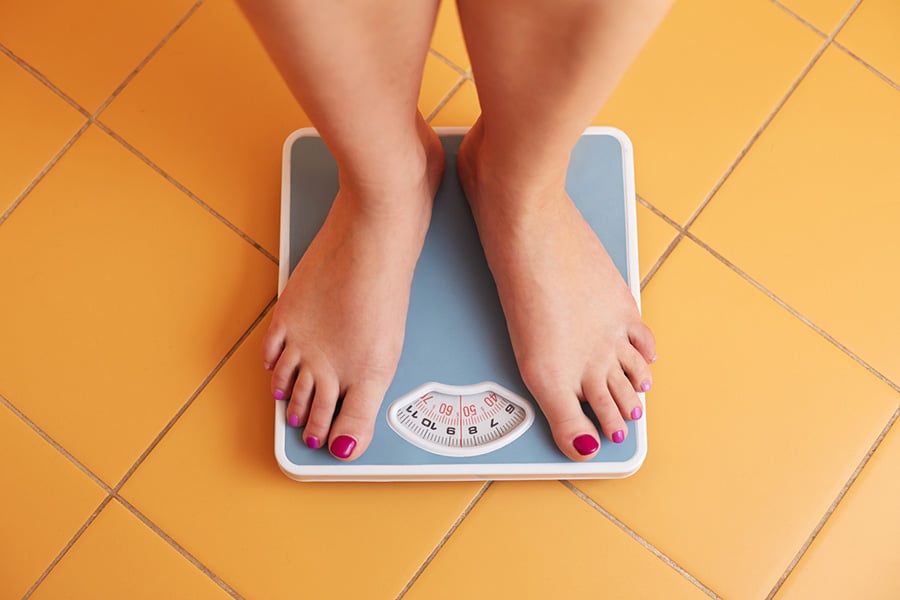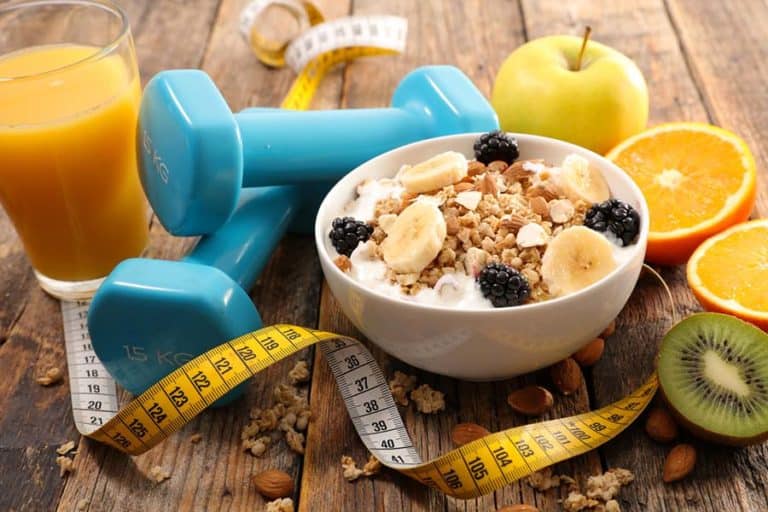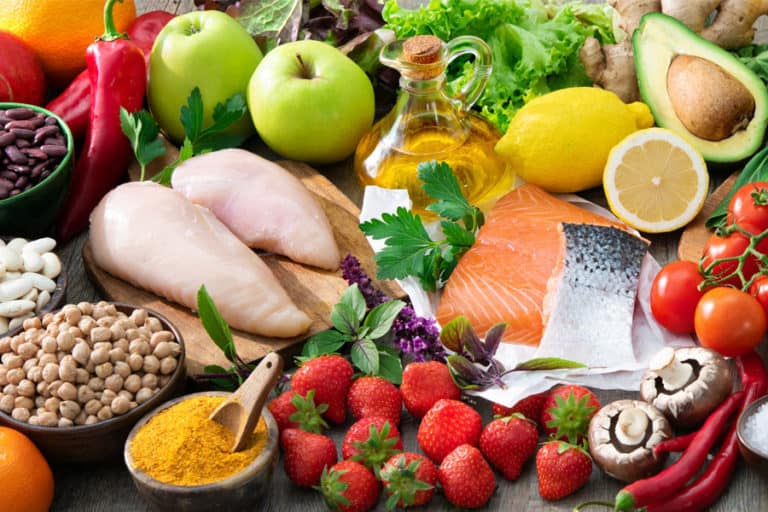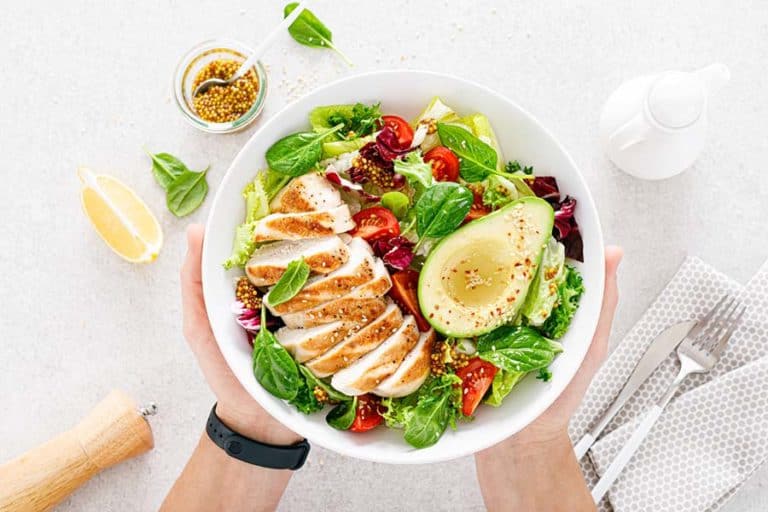How much weight can you lose in a month?

Wondering how much weight can you lose in a month? As per the Centers for Disease Control and Prevention, a person may be able to lose 4–8 pounds in a month.
These days, the prevalence of obesity is on the rise across the globe. In the United States, nearly two out of three U.S. adults are obese [1]HARVARD T.H. CHAN: An Epidemic of Obesity: U.S. Obesity Trends or overweight. Furthermore, one out of six kids and adolescents belonging to the age group 2–19 are obese. The alarming nationwide obesity rates have compelled people to find newer ways to achieve rapid weight loss and pave their way to a healthier lifestyle.
But, how much weight can you lose in a month without harming your health and well-being? If you are trying to shed extra pounds from your body and are wondering how to do that, this guide provides the exact information you are looking for.
How much weight can you lose in a month?
According to the Centers for Disease Control and Prevention (CDC) [2]Centers for Disease Control and Prevention: Losing Weight, an individual can lose roughly one to two pounds per week safely and effectively. So, a healthy rate of weight loss would be around 4 to 8 pounds (lb) in a month. However, these are just estimates. If you think about how much weight can you lose in a month, it depends on various factors, such as age, sex, diet, total body weight, fitness goals, weight loss goals, underlying physical problems, and so on.
11 ways to lose weight the healthy way
Wondering how to lose weight in a month quickly and in a healthy way? Well, there is no single super-quick trick for losing weight in a month. However, there are multiple things you can do to achieve the maximum amount of weight loss without compromising on your health or risking nutritional deficiencies. Given below are some of the best ways for safe, healthy, and sustainable weight loss.
1. Swap processed foods with whole foods
Processed foods have more calories, unhealthy fats, sodium, and sugar. So, one good rule to follow on your weight loss journey is to stick to consuming nutritious foods made of whole, single ingredients. Stick to foods such as whole grains, fresh fruits, vegetables, etc. Do not just consume fewer calories. Instead, consume foods that are rich in essential nutrients the body needs to function optimally.
2. Count on fiber-rich foods
Fiber-rich foods may help if you are trying to safely lose extra weight and achieve weight loss in a healthier way. Soluble fiber engenders sustainable and healthy weight loss by reducing your appetite and keeping gut bacteria healthy, eventually promoting healthy fat loss. Consuming upto 30 grams of fiber every day can help you lose weight effectively. For rapid weight loss, count on fiber-rich foods such as berries, vegetables, chickpeas, lentils, and oatmeal.
3. Ditch sugary beverages
Whether you drink soda, energy drinks, or fruit juices, these sugary beverages add liquid calories and put you at a heightened risk of obesity. Studies have shown a drastic 60% increase in obesity risk among kids who consume a sugar-sweetened beverage daily. To achieve a healthy one-month weight loss, replace sugar-laden drinks with healthy drinks such as coconut water, green tea, vegetable juices, and lemon water.
4. Stick to small portions
Small portions allow a person to eat less, while their larger counterparts encourage them to eat more and eventually cause unnecessary weight gain. Doubling the size of a dinner appetizer can increase calorie intake by upto 30%. So, practice portion control and serve yourself smaller portions to consume fewer calories. Pay attention to those hunger cues, your body does not require as much food as you might think.
5. Include protein in every meal
Protein is known to reduce hunger and keep one full for longer while relying on fewer calories. It promotes the growth of more muscle mass which in turn boosts the body’s metabolic rate. A scientific study [3]PubMed: A high-protein diet induces sustained reductions in appetite, ad libitum caloric intake, and body weight despite compensatory changes in diurnal plasma leptin and ghrelin concentrations found that increasing protein intake helped a group achieve 10–11-pound weight loss over a period of 12 weeks without intentionally restricting any foods. For your one-month diet plan, try opting for lean protein foods, such as lean beef, Greek yogurt, beans, lentils, and low-fat cottage cheese.
6. Prepare food at home
Wisely planned home-cooked meals encourage healthy eating. On the other hand, take-outs, fast-foods or pre-made meals that are high in calories result in unwanted body fat. Accelerate your weight loss journey by practicing healthy eating habits. Make your own meals to achieve the desired calorie deficit.
7. Get physically active
A regular workout regimen including cardio and strength training can help you achieve safe and healthy weight loss in a month. Physical activity not only promotes a quicker calorie burn but also decreases the risk of chronic diseases and improves moods and cognitive functioning. If you wonder exactly how much weight can you lose in a month through exercise, it will depend on your exercise plan, current fitness level, body composition, current body weight, and other factors. Try exercising daily for at least 30–45 minutes to lose a few pounds in a month.
8. Get plenty of good night’s sleep
Proponents of healthy sleep believe that sleep deprivation increases the urge to consume processed foods, thereby causing people to consume more calories than normal. Researchers have also found that lack of sleep compromises the efficacy of typical dietary interventions for weight loss. Try to sleep 7-8 hours a day if you are an adult.
9. Stay hydrated
Drinking enough water has been observed to promote overall weight loss. It promotes better digestion, improves metabolism, increases resting energy expenditure (REE), and also keeps you full for long.
10. Rely on a low-carb diet
Low-carb diets will help you lose those four to eight pounds a month(roughly 1-2 pounds per week) without any weight loss surgery. Healthy habits like limiting carbs and consuming more protein and healthy fats reduce your overall calorie intake and eventually result in weight loss. How much weight loss exactly occurs will depend on your actual diet along with exercise. The best diet to lose weight, in this case, will include all those low-carb foods, such as lean meat, leafy greens, nuts, seeds, fish, eggs, and healthy oils.
11. Count Your calorie intake
Calorie counting is the cornerstone of all weight loss programs. This does not imply that you have to resort to very low-calorie diets or some fad diets. Losing weight does not have to be very complicated. If you are trying to lose weight, you simply need to keep tabs on the ratio of your caloric intake versus your calorie burn.
Calorie intake to lose weight
If you are thinking about how many calories you should eat per day to lose weight, it depends on numerous factors. This includes your age, gender, height, physical activity level, current weight, and current energy intake, among several others. When trying to lose weight, you must create a calorie deficit by lowering your calorie intake either through diet or by exercising. Combining the two will ensure that you are eating the desired nutrients while consuming the right number of calories. Ideally, eat only healthy foods, steer clear of yo-yo dieting, and exercise daily to ensure healthy, sustainable weight loss.
To achieve your weight loss goal, use this calorie calculator to calculate the calories you need each day, so you won’t go overboard with your daily calorie consumption. Furthermore, count the calories burned with the help of a fitness tracker. This way, you will lose weight in a month quickly and effectively.
The tables below show how many calories you should eat based on the USDA [4]Dietary Guidelines for Americans: 2020–2025 Dietary Guidelines for Americans 2020–2025 Dietary Guidelines for Americans.
For women
| Age | Daily calorie requirements |
| 19–30 years | 1,800–2,400 calories |
| 31–59 years | 1,600–2,200 calories |
| 60+ years | 1,600–2,000 calories |
For men
| Age | Daily calorie requirements |
| 19–30 years | 2,400–3,000 calories |
| 31–59 years | 2,200–3,000 calories |
| 60+ years | 2,000–2,600 calories |
7-Day diet plan to lose weight in a month
| Day | Breakfast | Lunch | Dinner | Snacks |
| 1 | Oatmeal topped with nuts, 1 bowl of Greek yogurt | Grilled chicken salad, 1 apple | Shrimp with sautéed veggies | 1 Banana |
| 2 | Scrambled egg with spinach and tomato | Vegetable and hummus wrap | Soba noodles and chicken stir fry | Yogurt and berry parfait |
| 3 | Egg sandwich, 1 cup of mixed berries | Quinoa and veggie bowl | Baked wild salmon | Handful of nuts |
| 4 | whole wheat pancakes with raspberries, 1/2 cup low-fat milk | Crispy tofu bowl | Baked chicken breast with veggie greens | Sugar-free chocolate protein bar |
| 5 | Peanut butter and banana toast, 1 pear | Shredded chicken tacos | Baked lime chicken | Carrot stick and chickpea hummus |
| 6 | Tuna salad multigrain sandwich | Feta and peas omelet | Whole-wheat pasta with salmon and veggies | Apple slices |
| 7 | Oat and chocolate protein smoothie | Chicken salad with corn and lettuce | Sweet potatoes, sallops with salsa | A bowl of grapes |
Best exercises for reducing weight in a month
There are a few cardio and strength training workouts that can help you achieve the desired results. Here is a list of exercises you can do at home to reduce significant weight in a month.
| Exercise | Number of sets/duration |
| Jumping jacks | 3 (10-15 reps) |
| Burpees | 3 (10-15 reps) |
| Squats | 3 (10-15 reps) |
| Skipping Rope | 15 minutes |
| Leg Raises | 3 (10-15 reps) |
| Crunches | 3 (10-15 reps) |
| Lunges | 3 (10-15 reps) |
| High Knees | 3 (10-15 reps) |
| Push-ups | 3 (10-15 reps) |
Do you really need to go on a diet to lose weight?
You do not have to resort to any extremely low-calorie diets to lose 4-8 pounds in a month. Experts believe that the most effective weight loss plan involves exercise, a good diet, and healthy lifestyle practices rather than crash diets. When you are on a crash diet, you may put more food on your table since it’s challenging to be restrictive for so long. Instead, focus on what you eat and make sure it is healthy.
Who should not go on a diet?
Going on an unrealistic diet or long fasting phases makes a person weak and sick in the long run. It can induce constipation, headaches, and other symptoms. Dieting deprives the body of crucial nutrients, and causes eating disorders. You should not go on a diet if you:
- Are pregnant
- Are diabetic
- Have an eating or digestive disorder
- Have kidney problems.
Foods to eat vs foods to avoid for weight loss
As aforementioned, how many pounds you can lose in a month will depend on the foods you eat. Here is a list of foods to eat and foods to avoid for weight loss.
Foods to eat for weight loss
- Whole grains
- Lean meats
- Eggs and low-fat dairy
- Fresh fruits and vegetables
- Fish/seafood
- Nuts and seeds
- Legumes
- Healthy oils
Foods to avoid for weight loss
- Alcohol
- Dried fruits
- White pasta, bread, rice, etc.(they are highly refined and processed)
- Processed and junk foods, such as cracks, chips, hamburgers, etc
- Sweetened beverages, such as fruit juices, soda, etc
- Foods with added sugar
- Baked foods, such as cookies, cake, pastries, etc
Conclusion
On average, aiming to lose 4 to 8 pounds per month is a healthy goal. To attain one’s weight-loss goals, one should focus on the right diet, exercise, and healthy lifestyle changes, such as sleeping for 8 hours and ditching alcohol.
Stay consistent with whatever you follow for safe, healthy, and sustainable weight loss. Consult a doctor if you have underlying health problems such as diabetes, high blood pressure, or heart disease before trying to lose weight.
References
| ↑1 | HARVARD T.H. CHAN: An Epidemic of Obesity: U.S. Obesity Trends |
|---|---|
| ↑2 | Centers for Disease Control and Prevention: Losing Weight |
| ↑3 | PubMed: A high-protein diet induces sustained reductions in appetite, ad libitum caloric intake, and body weight despite compensatory changes in diurnal plasma leptin and ghrelin concentrations |
| ↑4 | Dietary Guidelines for Americans: 2020–2025 Dietary Guidelines for Americans |







